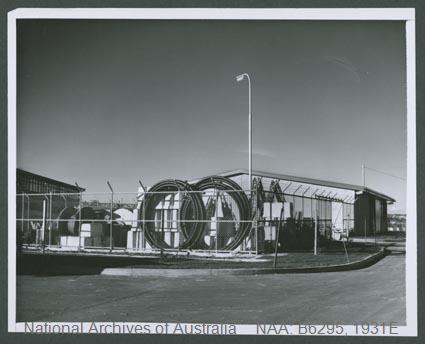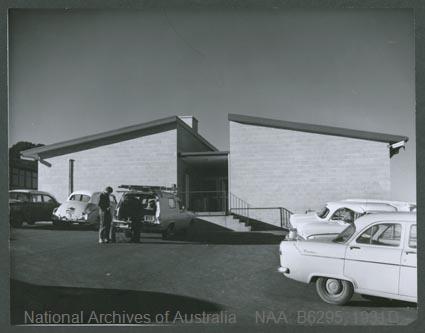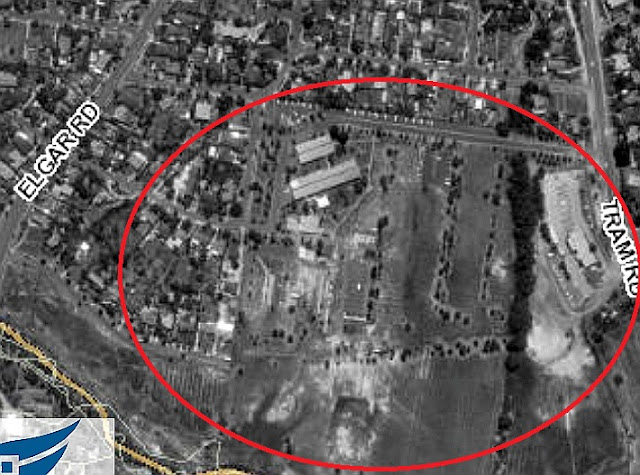Laboratory for Cable Jointing instruction 1968
Background
This is an on-line research project describing the former Telstra Doncaster Line Depot and Training School, which covered a total area of 9.3 hectares (approximately) with a main frontage to Tram Road.
The site was was approximately rectangular in shape, consisting of two portions:
- a 0.7 hectare portion known as the Doncaster Line Depot;
- a 8.8 hectare portion known as the Training School.
The site was originally acquired by the Commonwealth of Australia in 1950 with ownership later transferred to Telecom. Prior to 1950, the land was most likely used for orchard and/or grazing purposes. The training school was built between 1967 and 1968, the Line Depot was built in 1963.
The two portions were effectively delineated by an unnamed tributary to Koonung Creek running in a north-south direction and draining run-off into Koonung Creek. ’
The topography of the site was such that it was situated on the northern slopes oi the valley of Koonung Creek. Overall the site slopes gently southwards to the creek. The site is bounded by Tram Road and residential properties to the West, the Eastern Freeway to the south, Neil Street to the west and residential properties to the north. Parks and recreational areas are located along Koonung Creek.
Improvements on the total site (i.e. Training School and Line Depot) included office complex, store rooms, classroom, paved carparks, concrete cable junction training pits and various storage areas. A store yard of scrap metal and building materials was located on the land situated between the creek and the Line Depot. The site was zoned PPI Commonwealth and Telstra sought to rezone the land in 1996.
History
- pre-1950 Commonwealth land - grazing and fruit orchards
- 1950 Site acquired by Telstra (PMG)
- 1963 Line Depot built on Tram Rd frontage
- 1966-1967 Line Training Section built in NW section on Neil (Neel) St frontage
- 1996 Structures and sub-surface features demolished
- 1997 Site sold to Gandel Developments
- 1998 Environmental Impact Audit Report commenced
- 2001 Audit Report completed
- 2002 Site clearing undertaken
- 2003 The watercourse/tributary was converted to a large diameter underground barrel drain
- 2005 Applewood Retirement Village construction commenced
- 2006 Applewood Village completed
Storage shed 1968
Storage Shed 1968
Main Lecture Room 1968
Canteen 1968
Training Centre under construction 1967
Training Centre 1968
Training Centre 1968
Training Centre 1968
Training Centre under construction 1967
Training Centre nearing completion 1967
Training Centre under construction 1967
Training Centre under construction 1967
Conference Room 1968
Main Entrance 1968
Line Depot aerial view (red circle) 1963
Training Centre and Line Depot (red circle) 1974
Applewood Village main building 2021
Training Centre under construction, Line Depot in distance (1967)
Applewood Vlllage in 2021 (Manningham)
Original Land Title 1950
Applewood Village 2021 (Google Maps)
Plan of Site 1996
Below: Lineman Training School, Fishermens' Bend (Victoria), in 1945. This was in use until the mid-1960s when it was closed and operations moved to Doncaster. The site was then used for the pre-installation of Telstra ARK telephone exchanges.
Principal References and Acknowledgements
Environmental Audit Report 2001
https://apps.epa.vic.gov.au/EnvAuditFiles/53X/36175-3/36175-3_a.pdf
Manningham City Council
Whitehorse City Council
National Archives of Australia
Google Maps
Telstra Australia
Appleview Retirement Village
National Library of Australia (Trove)
Gandel Developments
Author's Notes
Training in Telstra for the Future
In the early 1950s. the Commonwealth Gov. had commenced the rollout of a massive commitment to expansion of the Switched Network, with the progressive replacement of Manual Exchanges, Analogue Switching technology, and the introduction of computerized switching (such as 10C, AXE, System 12, Crossbar,etc.) This was associated with large-scale conversions of open wire systems to cable, some of which had been laid in the 1910s.
To support this expansion, the PMG's Dept. recruited thousands of young men fresh out of high school and adults (including returned ex-servicemen) for Technical and Lines appointments. Instructional staff were drawn from technical and lines ranks
Training Centres were set up in all capital cities and regional locations, many being converted factories, old mansions, disused warehouses and leased industrial properties.
Some readers may recall the "Open Tech", "Nine week", "12 weeks" and "16 week" fast-track training mature-age courses for Technician and Lines staff of the 1950s.
Ultimately, the PMG/Telstra moved away from teaching its own, in favour of Apprentice training, and modular specialised learning delivered from the TAFE system.
Massive national Recruitment of trainees for Technical and Lines appointments occurred until the late 1990s when major policy changes resulted in Telstra closing most of its in-house training schools. Future mass intakes were scaled down in favour of modular on-demand short courses.
The Year of 1956
This photo above is of the author's group in 1956, at the PMG Technicians' School at Batman St, East Melbourne (converted factory!)
Trainees were expected to dress neatly (with ties!)
Top left L-R: author, Malcolm Atkinson, Laurie Phillips, Alex Lancefield, Graham Gall (at rear), Graeme Terry
Second row L-R: Stuart Whitechurch, Keith Campbell, Ken Hosking (Group Leader), Norm Shallard, Ken Denison
Front row L-R: Dave Ashley, Ian Williams, Barry McPhee
(Note: Trainees from the Victorian Railways and Dept of Civil Aviation participated in the PMG scheme)
The following is an extract from the author's autobiography, describing life as a Trainee from 1956-1960
In late 1955, whilst in Form 5 at Camberwell High School, the time was approaching to decide what to do for a full time living. It was not possible for me to continue on to Form 6, and ultimately University, as my parents could not afford the fees. I underwent a vocational guidance assessment, and the results were somewhat vague, suggesting that my career path should be “something technical”!
I decided to contest the Australian Public Service entrance examination, along with thousand of other kids,.
In
late 1955,
I was offered a position in the
Postmaster’s General’s Department as a Trainee Technician, a five year
course
in Telecommunications, and commenced
on January 9, 1956, aged 16 years.
This
was not really my first preference,
as I had wanted to join the Department of Civil Aviation as a Trainee
Technician in radio,
but there were very few vacancies
there.
So I entered the PMG’s Department, completing the course in December 1960, and gained an award for Dux of the school in my final year .
1956 was Melbourne’s Olympic Games year!
I would remain in the Department, for 41 years, through its various transformations, to the present-day entity Telstra, ultimately leaving in 1997 as the beneficiary of a very generous voluntary redundancy package.
On leaving the Company, my substantive designation was Professional Engineer, Level 4, and I had been employed as an Engineer since January 1965, across many areas of involvement..
Background
From the early 1950s, the Government had embarked on a massive Telecommunications expansion program, nationally.
This included the replacement of all magneto and Central Battery "CB" telephone exchanges and telephones, the conversion of old Strowger exchanges (dating to early 1900s) to the modern 2000-type system, the introduction of direct dialling of trunk calls without the need for an operator, the construction of hundreds of small automatic Crossbar exchanges in rural and semi rural areas. and the laying of new pit and pipe to support the program..
It also saw the phasing out of aerial/overhead wires with underground cable, and the replacement of old dial-type telephones with modern push-button instruments.
New switching systems were becoming available, such as Stored Program Control (SPC) which used the Swedish Crossbar system instead of the older archaic electromechanical "step" switches.
New National Training Scheme
To assist in managing the massive increase in network capacity, a huge commitment was made to the recruitment and training of technical staff, mainly through the introduction of the five-year Trainee Technician program, which ran from the early 1950s into the 1960s.
Trainees were 15 or 16 year olds, many from country areas.
Selection for training required passing of the annual Commonwealth Pubic Service entrance exam.
Thousands of Trainees passed through the scheme, who after graduation were appointed to disciplines of telephone exchange maintenance, telephone exchange installation, telephone maintenance, long-line equipment installation and maintenance, radio, or PABX installation and maintenance.
Since the late 1940s, shorter training schemes for adults had been operating where returned servicemen and other adults could undertake training for up to four or 18 weeks.
To manage this massive "TIT" program, training schools were set up in major capitals, some housed in converted factories, stores, Victorian era mansions, or warehouses.
In 1956, there were three schools in Melbourne - two in West Melbourne (Batman St and King St), and in South Yarra (the former "Grong Grong" mansion)
In 1964, these schools were discontinued as part of a site rationalization program, in favour of a refurbished larger establishment in East Hawthorn, in Auburn Rd, the former Westclox factory.
The first year of training was at the schools where trainees would learn basic practical skills specific to the Dept's needs, and theoretical training.
My wages, in 1956, were 25 shillings a week!
In the second and following years of training, field training to various work centres would be arranged, usually close to trainees’ places of residence, and supervised by senior technical staff and Field Supervisors.
Some school attendance was also required.
These field visits would range from one to four weeks and trainees’ work and performance would be closed monitored and assessed.
In parallel with the TIT scheme, a Lineman-in-Training scheme was operating, offering training in eternal field practices for several weeks, which would include cable jointing, external plant construction, and pit and pipe work.
LIT schools had been set up in various capitals.
In Melbourne, the main Lineman’s School was located at Fisherman’s Bend, adjacent to the Yarra, and we, as TITs had to survive a four week stint here in mid winter to gain an appreciation of skills and practices relevant to external plant.
The Fishermens’ Bend centre had its origins in the war years, and was on land owned by the nearby Commonwealth Aircraft Company and the former Fisherman’s Bend airport.
It consisted of a large open paddock, with a central admin block where lectures were conducted. The practical work was done in converted "Nissen huts" - wooden floors, and curved tin walls and roofs.
In the third year, the amount of time spent in the Technicians school was reduced, and field visits were extended.
In fourth and fifth year, Trainees were allocated to their final "stations" with only minimal attendances at the schools.
Copyright 2021. Unless indicated otherwise, no part of this publication may be reproduced, stored in a retrieval system, or transmitted in any form or by any means, electronic, mechanical, photocopying or otherwise without the prior written permission of the author




























